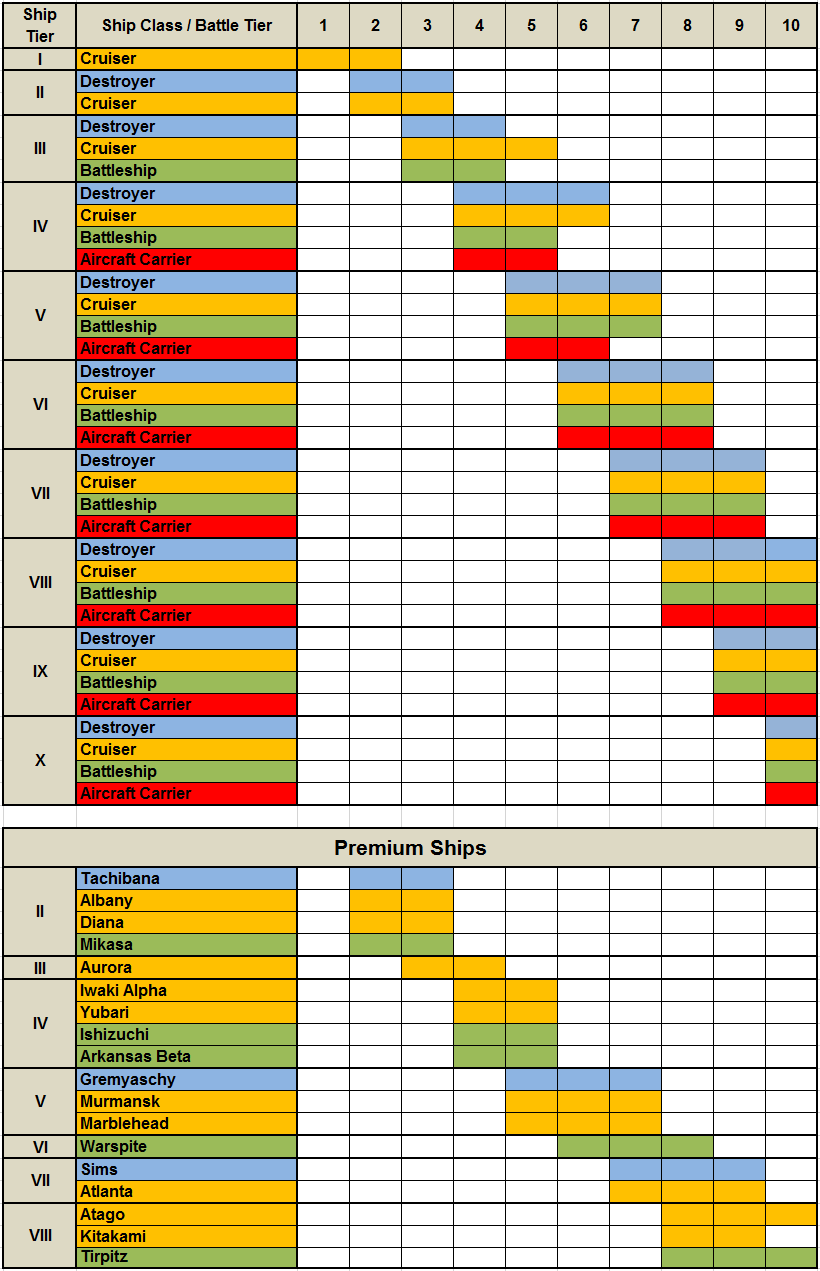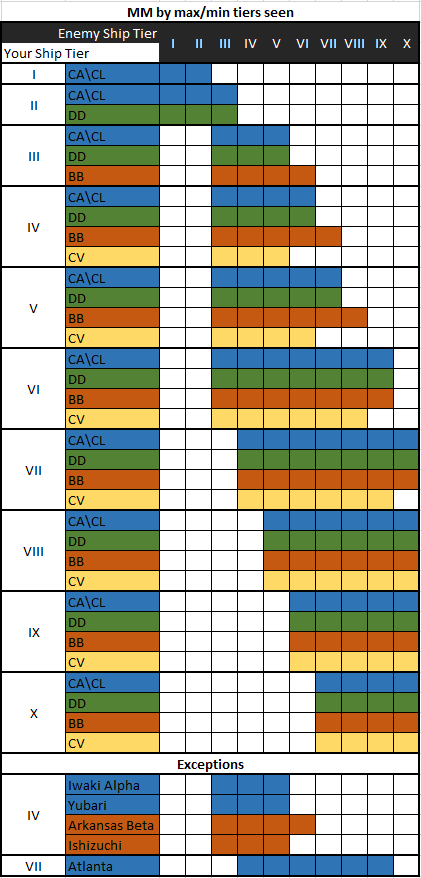Difference between revisions of "Ship:Matchmaking"
| Revision as of 17:34, 15 September 2015 | Revision as of 14:50, 23 September 2015 Divisions Corrected some vague/incorrect language. | |||
| Line 15: | Line 15: | |||
| Divisions of up to three ships can be created. Currently divisions can only have one carrier (and a random team can have no more than two carriers). | Divisions of up to three ships can be created. Currently divisions can only have one carrier (and a random team can have no more than two carriers). | |||
| ? | Matchmaker treats all the ships in the platoon as having the | + | Matchmaker treats all the ships in the platoon as having the highest present tier; so if, for example, a tier 3 and a tier 7 ships division together, matchmaker views both of them as tier seven ships and will assign them to battle accordingly. For that reason, it is never a good reason to platoon with ships that vastly differ in tiers (so-called "fail divisions") -- you will weaken your team, and draw the wrath of your teammates. | |
| == Ship Performance Factors == | == Ship Performance Factors == | |||
Revision as of 14:50, 23 September 2015
Matchmaking (MM)
Each ship has a certain combat tier assigned to it. It determines the maximum level of enemy and ally ships that can be encountered in the battle.
The information below is current as of patch 0.5.0
Legacy MM information for CBT/OBT:
Divisions
Divisions of up to three ships can be created. Currently divisions can only have one carrier (and a random team can have no more than two carriers).
Matchmaker treats all the ships in the platoon as having the highest present tier; so if, for example, a tier 3 and a tier 7 ships division together, matchmaker views both of them as tier seven ships and will assign them to battle accordingly. For that reason, it is never a good reason to platoon with ships that vastly differ in tiers (so-called "fail divisions") -- you will weaken your team, and draw the wrath of your teammates.
Ship Performance Factors
For each ship there are five main performance factors that provide a basis for comparison of any one ship against another in game. There are an additional two performance factors for those ships which are armed with aircraft or torpedoes. These performance factors are expressed on a relative scale of 0 (worst) to 100 (best). Each performance factor is calculated or influence from a combination of other individual factors as follows:
- Survivability is a measure of the ship's ability to take damage and keep fighting. Its mainly all about hit points. The T10 BB's IJN Yamato and the USA Montana share top Survivability factor in-game with 100. The USA T1 PB Erie has the worst with 9.
- Artillery is a measure of the ship's firepower with its main and secondary guns. The main battery firing range in kilometers and the number, type, and positions of the main battery and the secondary armament guns contribute to this factor. The IJN T10 BB Yamato and the USA T10 BB Montana share top Artillery factor in-game of 73. The IJN T2 DD Umikaze has the worst with 16.
- AA Guns is a measure of the ship's anti-aircraft defenses and its ability to defend itself from air attacks. The number and caliber of the on-board AA guns contribute to this factor. The USA T10 BB Montana has the best AA Guns factor in-game of 94. The USA T4 CV Langley and T2 CL Chester have the worst because they are not armed with any AA Guns.
- Maneuverability factor is a measure of the ship's ability to maneuver, make turns, and maintain speed while turning. Three other factors affect Maneuverability, the ship's "Maximum Speed" in knots, its "Turning Circle Radius" in meters, and its "Rudder Shift Time" in seconds. The IJN T5 DD Minekaze has the best Maneuverability factor in-game of 97. The USA T4 CV Langley has the worst at 7.
- Concealment factor is a measure of the ship's ability to remain undetected by the enemy. The Concealment factor is a calculated parameter influenced by the ship's "Surface Detectability Range" and an "Air Detectability Range", each are also specified and expressed in kilometers. The IJN T2 DD Umikaze has the best Concealment factor in-game of 97. The USA T10 CV Midway has the worst at 5. The Type-1 Camouflage presumably further reduces the detectability range by enemy ships by 3%.
- Torpedoes is a measure of the torpedo capability of those ships which carry torpedoes. The number, type, and position of the torpedo tubes and the range of the torpedoes contribute to this factor. The IJN T10 DD Shimakaze has the best Torpedo factor in-game of 63. The IJN T2 DD Umikaze has the worst with 7. Those ships not armed with torpedoes have no Torpedo factor.
- Aircraft is a measure of the aircraft capability of those ships which carry aircraft. The total number of squadrons, number of planes, and the type and capabilities of each of the planes: fighter, dive-bomber, or torpedo-planes; determine the Aircraft factor. The USA T10 CV Midway has the best in-game Aircraft factor of 79. USA Cruisers beginning with T5 CL Omaha and IJN Cruisers beginning with T4 Kuma carry only 1 to 3 fighter/recon aircraft and share an in-game Aircraft factor of 1. Those ships not armed with aircraft have no Aircraft factor.
Spotting Mechanics
Spotting in World of Warships relies primarily on the detection range of the ship being spotted. This involves four numbers, assuming that line of sight exists.
The first set of numbers is detection range, which is divided into two categories
- Detection range from surface ship: This is the range that an enemy ship has to approach in order to detect your ship. If no ship is inside this range, you will not be detected by another ship.
- Detection range from aircraft: This is the range at which an enemy aircraft has to approach the ship in order to detect it. This is usually shorter than the detection range from surface ships.
The second set of values is View range, also known as your render range. It is identified as the grey cone on your minimap in game. Any ship outside of it will not be drawn on your screen, and can not be detected by you. In most cases, view range is irrelevant, because it is usually far higher than the detection range of the ship you are attempting to spot. Aircraft carriers have unlimited view range, and planes have a high view range also. The only time view range affects detection is when the spotting ship has a lower view range than the target, such as a destroyer attempting to spot certain battleships. In these cases, the ship is spotted the moment it enters the view range of the spotting ship.
- Firing a main gun or AA battery will temporarily increase your detection range, allowing you to be spotted at a distance higher than your listed detection range. Thus it is often recommended to turn off your AA guns on destroyers so they do not reveal your position by shooting at passing aircraft.
- Smoke works by blocking Line of Sight. If you are in a smoke cloud or have a smoke cloud between you and all possible spotters, you can remain undetected inside your detection ranges. However, there is a 2km "auto-spot" range, which will spot you through smoke. Hydroacoustic Search will also spot through smoke as long as you are in its auto-spot range.
- Torpedoes have their own detection ranges, which are the same from both surface ships and aircraft. However, if a torpedo is spotted, it will remain spotted for the duration of its run.

